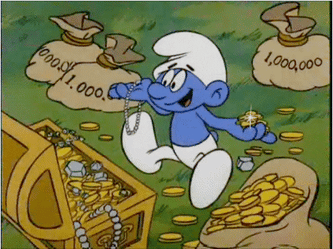Customer Acquisition? 🔥 Done! So What’s Your Customer Retention Plan?
Have you ever moved to a new city with no one? Or maybe started a new job and want to befriend people in your workplace? Or maybe you started the new year and wanted some new connections.
I certainly have. When I first moved to Seattle I tried all sorts of tactics to make friends. I even tried an app for it. And I met some nice people.
I mean, it was definitely nice to have plans. But I quickly realized this wasn’t a way to make lasting friendships. I needed to try something else.

It’s funny, but retaining customers has some similarities to making friends (you probably won’t be going on hikes or drinking beer with your customers though).
With friends, you might have many short term, fleeting connections with people.
But making real friends takes a bigger risk. And a bigger investment.
Just like how you might draw in customers in different ways. And some of those ways might be pretty effortless. But how are you going to keep them?
Usually, if you expect to retain your customers, you’ll need to devote time and resources in a much bigger way.
So we’re going to explore that a bit in this post.
Preventing churn is a great way to build a sustainable business model, but it can be difficult. Yet, the results are well worth it.
The reason it can be such a challenge is because there’s many moving parts.
For sure, it demands a great, customized relationship with your customer.
But to be truly excellent, it also demands both data, and using that data well!
It’s usually not a quick win. It's something that comes with careful orchestration of a timed strategy.
But, the fruits of labor come to those who persevere!

You’ll see amazing results if you don’t lose sight of the big picture, and don’t focus too much on fast results.
Specifically, customer retention pays off big time in the following 4 ways:
- Happy customers tell others and create a bit of viral buzz that makes it easier to acquire more. Your foot in the door already for more customers!
- Customer retention provides a more resilient foundation for stormy weather
- You’ll see a better CLTV: CAC ratio—important for when you do want to shift to customer acquisition
- Customer retention creates a higher NRR which leads to greater company value
We’ll explore each of these points further below.
Your customer is your best advocate, and is the key to long-term business health
As we all feel the heat of the market, we’ve got to make mindful, strategic decisions.
No one wants to be on the chopping block in 2023. 
Even if there aren't big short-term gains from your initial retention efforts, having loyal customers means that there will likely be bigger returns down the road.
And consistent customers are your best advocates—they can speak about your product to their colleagues and connections.
It’s a much more believable sell coming from them than it is from you.
Your customer's word on trusting you is your greatest asset.
This is one part of the retention equation, and can be thought of as a qualitative marker of the value of your product.
So think deeply on how you are working to build this trust.
Are you backing up the suggestions and ideas you offer your customers with data? Is it the right data?
Are you making the resources and relationships that you have work harder for you?
It’s not just us saying this—Joe Morissey from Andreessen Horowitz wrote “We’re in the middle of a major consolidation of software investments, dollars are scarce, and customers need to maximize the ROI on every dollar spent."

So that trust combined with proven insights is going to be your best asset this year. No one is keeping a product on the shelf that doesn’t manifest profits.
The longer you wait to get started on customer retention campaigns, the harder it gets to catch up. The more effort you put in now will save you time later.
Stay with me here...
Customer retention provides a more resilient foundation than customer acquisition
So now you’ve determined who the “right customer” is. Great!
And you’ve completed your initial sale. Excellent!
Now you want to make sure they're happy about being your customer so much so that they continue buying from you even after the initial excitement wears off.
And not just happy because they’re saying they are—but also happy from a numbers perspective.
The biggest mistake that businesses make is focusing on acquiring more customers without thinking about how they can keep them around for longer.
So much of what has been the name of the game for SaaS companies has been growth at all costs.
But the shift to efficient growth has emphasized that this mindset isn’t right.
Sure, growth at all costs might have worked when funding was plentiful (and cheap). 
But now, every business is looking for where cuts can be made.
We're seeing this across the board. It’s true with recruiting, advertising spend, and entire teams being done away with in favor of the bottom line.
It’s no longer the right move for most companies to funnel high amounts of their budget into new customer acquisition.
Finding the right customers who have an ongoing need for your product is much, much more cost-effective.
Is it important to get new customers? Of course. But, it’s just as important to refine acquisition efforts towards fewer, higher-quality leads. This will be more profitable in the long run.
But, with shaky economic grounds, keeping the ones you have is key.

As you already know, customers are simply not a “set and forget” part of your business.
They are unique and have specific needs from your customer success and account teams.
Customer needs are typically ongoing too.
Some might be happy with the occasional email asking how the product is working for them. This customer might be so technically savvy, they’re pretty hands off.
But you might have another customer whose first exposure to a product in your realm is yours. They’re starting from scratch.
And there’s a lot of pressure on them to make sure that the investment is worth it.
So you’ll spend much more time fetching information and answering questions for them.
This might require weekly standing meetings.
So now, let’s jump to ensuring that we keep the customer long enough to be profitable, and ensure the costs of recruiting and onboarding them were worth it.
Using Customer Acquisition Cost (CAC) vs Lifetime Value (CLV) to evaluate retention
Let’s dive into some metrics.
Now that you understand the value of a strong customer foundation, we can utilize Customer Lifetime Value (CLV, LTV, or CLTV) and compare it to your Customer Acquisition Cost (CAC).
Comparing these two was the standard when SaaS first started, back in the late 90’s and early 2000’s.
Let’s begin with CAC!

CAC is defined as how much it costs to “get” a customer, and accounts for the efforts taken to market and sell to them.
As Hubspot says, CAC is “The total sales and marketing cost includes all program and marketing spend, salaries, commissions, bonuses, and overhead associated with attracting new leads and converting them into customers.”
CAC is the first cost that you’ll look at as the customer journey begins- how much did it cost for them to decide to purchase with you?
So then what is CLV?
Customer Lifetime Value is defined as “The profit margin a company expects to earn over the entirety of their business relationship with the average customer.” (according to Clevertap)
You compare the total value you get from a customer over the entire customer journey, minus all of your efforts to attract, onboard, and retain that customer.
Then, you’re left with your Customer Lifetime Value.
So if you have a very high marketing and onboarding cost associated with your customers, but aren’t keeping them long enough, you know that something needs to change.

Typically, having a 3:1 ratio of LTV to CAC is considered “good”.
In this scenario, you’re retaining customers, and some upsell and cross-sell is occurring, but there’s still room for improvement.
If the ratio falls below 1:1, you’re losing money, as your acquisition cost is higher than what the customer spends on you. (Userpilot)
You’re in a leaky bucket scenario where you might have customers, but the initial investment in getting them isn’t paying off.
This is a tough spot to be in and means that something in the customer journey is not working.
They don’t see the value in keeping you around.
In 2023, no one can afford to be here.
It’s easy to see how customer retention is followed by a stronger CLV.
This is one reason that spray and pray marketing never worked.
You can’t spend (and waste) immense amounts of money on marketing and then not capture the long-term benefits (i.e. revenue) from your customers.
It takes a more mindful, orchestrated approach.
To remain profitable, you need to make sure they stay with you long enough that your CLTV outweighs your CAC.
Along the line, you also need to ensure that they’re growing as they stay with you.
Now, we can take a look at another helpful metric (one we really like here at Tingono) for retention.
Net Revenue Retention- A Better Way of Understanding Your Business
So customer retention is important.
And examining our acquisition cost against lifetime value can help us solve parts of the puzzle.
We know this. Now what’s a way to put it into action?

And what’s a more modern, unified approach to looking at performance?
Utilizing your Net Revenue Retention metric to guide your choices!
Remember, NRR can be used across your entire business as well as by individual teams.
Super helpful.
We’ve sung the praises of utilizing NRR before, and today isn’t the day we stop.
Net Revenue Retention helps you understand holistically how your business is performing.
It’s extra helpful because it tracks both retention and upsell/cross-sell.
And we really love it because it gives you a more detailed look at how the current accounts you have are tracking.
You can also utilize Gross Revenue Retention (GRR) to understand your performance with retention isolated from other metrics.
As noted by Sage Interactive, “GRR tells you how happy your customers are and reflects the stability of your company.”
So, your GRR gives you a big picture of your companies progress.
However, Gross Revenue Retention (GRR) doesn’t account for key growth opportunities like upsells and cross- sells.
NRR is better for examining some of the smaller details.
But, when you utilize metrics like NRR and GRR side by side, you can help to break down data siloes.
They can help your post-sales CS and/or AM teams focus on where there is opportunity to generate more revenue from customers.
They can better diagnose issues with customers and prevent them going forward.

These metrics help everyone have a common understanding of the direction the business is headed, and give teams actionable steps to improve themselves and the customer experience as a whole.
It’s in the name- when Go To Market teams better understand their revenue retention rate, they can better understand where they could improve their customers journey with the product.
So what does all this mean for you? Well...
Tingono can help you solve for the long game of retention
Like we’ve said, customer retention is an essential part of growing your business, but it's not something that happens overnight.
It requires a long-term commitment from both you and your customers, and it's important to keep that in mind as you're working on your current strategy.
Shifting your focus to building a sustainable business that can stand on its own two feet without having to constantly fight for new customers at all times can be great.
But, is there maybe something that could make this a little easier? 🤔

If you don’t know where to start, talk to us.
Here at Tingono, we’re working on helping businesses retain customers with proven, AI-driven models.
We know that retention can seem so far away that it doesn’t seem to have a strategy.
But we can help make the data you have something useful to derive insights.
Our models make specific suggestions to clarify what to do next to prevent churn and expand customers.
We make using your data easy while also leveraging automation so your customer success and account teams can remain focused on what’s most pressing.
Book a demo today if you’re interested in the future of revenue retention and staying engaged in the long game.





